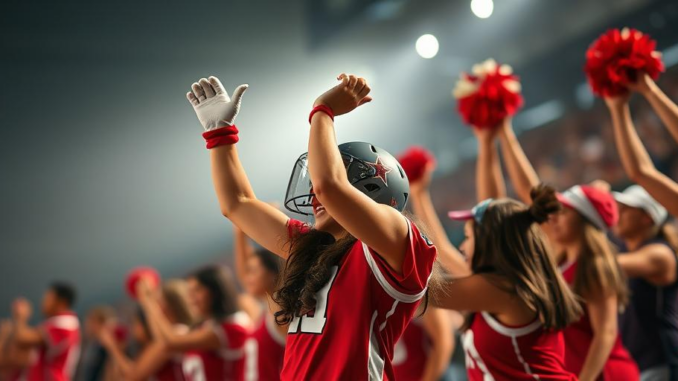
Summary
The American Academy of Pediatrics (AAP) has released updated safety guidelines for cheerleading, emphasizing injury prevention and comprehensive athlete care. These recommendations address key areas such as qualified coaching, preparticipation physicals, emergency preparedness, and concussion awareness. By implementing these guidelines, stakeholders can contribute to a safer and more enjoyable cheerleading experience for young athletes.
Reliability and uptime matter in healthcare TrueNAS provides 24/7 support when it counts.
Main Story
Cheerleading – it’s more than just pom-poms and sidelines, right? It’s a demanding sport with incredible stunts, jumps that defy gravity, and tumbling passes that leave you breathless. Across the US, we’re talking about roughly 3.5 million young athletes who dedicate themselves to this, and that’s why safety needs to be priority number one. The American Academy of Pediatrics (AAP) gets it, and they’ve just dropped some updated policy recommendations to help keep these athletes thriving.
Think of these guidelines as a playbook for a safer cheerleading experience. Actually, these are the first revisions since 2012! So, the AAP isn’t just throwing out random suggestions. Instead, they’re focusing on injury prevention and better athlete care. From those initial physicals all the way to how to handle emergencies, it’s all in there. And the great thing is, it’s not just for doctors. Coaches, parents, even the athletes themselves can use this to work together and make cheerleading as safe, and as fun, as possible.
Now, that pre-participation physical exam (PPE) – it’s a big deal. It’s basically an annual health check-up that helps doctors spot anything that might make an athlete more prone to injury. Plus, it’s a chance for a real conversation. Doctors, athletes, and families can all talk openly about risks and how to avoid them. It’s kind of like getting a pit stop before a race. I remember when my cousin’s daughter started cheer, they found out during her PPE she had a slight heart murmur, so they tailored her training!
Coaching is key, and you can’t skimp on it. The AAP stresses the importance of having qualified, certified coaches. You want people who know their stuff, especially when it comes to safety techniques, such as spotting. Spotting, in case you don’t know, is providing support during those tricky stunts. A good spotter can be the difference between a safe landing and a trip to the ER.
Here’s a thought: Why aren’t all states recognizing cheerleading as a real sport? The AAP is pushing for all 50 states to give cheerleading programs the same support and attention as other school sports. That means better coaches, better facilities, and tracking injuries. Why wouldn’t you want that?
Emergency preparedness! Every gym, every practice space needs a clear, written emergency action plan. What happens if someone gets hurt? Who do you call? Where’s the first-aid kit? You don’t want to be scrambling when every second counts.
Concussions are no joke. And the AAP is really pushing for awareness. Everyone – cheerleaders, coaches, parents – needs to know the signs and symptoms. Catching a concussion early is critical to prevent long-term problems. For example, headaches, dizziness, and confusion should all raise a red flag!
And there’s more to it! The AAP has tons of extra guidance. Things like keeping pyramid heights reasonable, making sure spotters are always there, and only using facilities that meet safety standards. Proper conditioning, warm-ups, and gradually increasing skill difficulty are all crucial too.
Look, by following these recommendations, we can really make a difference. Pediatricians, coaches, parents, athletes – we all have a role to play. Cheerleading is a fantastic sport, and with a focus on safety, it can stay that way for years to come. Who knows? Maybe this will spur you to advocate for changes in your local cheer program, or to just double check safety guidelines! And as the sport evolves, so too must our vigilance.


The emphasis on qualified coaches is crucial. Beyond spotting techniques, their understanding of progressive skill development and athlete conditioning directly impacts injury rates. How can we ensure access to affordable, high-quality coaching certification programs across all communities?
That’s a great point! Affordable certification is definitely key. Perhaps we could explore grants or subsidies to reduce the financial burden for coaches in underserved communities. Mentorship programs pairing experienced coaches with newer ones could also help build skills and knowledge. What are your thoughts on that?
Editor: MedTechNews.Uk
Thank you to our Sponsor Esdebe – https://esdebe.com
So, about those pre-participation physicals… does anyone else think we should include a mandatory “sparkle check” to ensure maximum glitter application? Safety first, but fabulousness is a close second!
That’s hilarious! A “sparkle check” would definitely brighten up the PPE process. Perhaps we can propose a pilot program to assess its impact on team morale and overall fabulousness. It could be a game changer! How about including it as an addendum to the concussion protocol?
Editor: MedTechNews.Uk
Thank you to our Sponsor Esdebe – https://esdebe.com
Mandatory pre-participation physicals? Genius! Though, I’d add a mandatory “how-to-handle-sequins” class for coaches. Nothing’s more dangerous than an rogue sequin during a dismount. We could save countless emergency room visits!